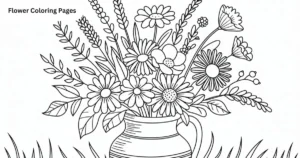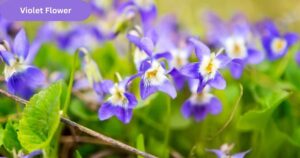Violet flowers are known for their striking color and rich symbolism. With delicate petals and a pleasant scent, they add charm to gardens and homes alike. These flowers come in various shades of purple, from deep plum to soft lavender. Appreciated for their beauty and resilience, violet flowers have fascinated cultures for centuries.
Whether you’re a gardener, nature lover, or flower enthusiast, the violet flower is worth exploring. From its historical importance to modern-day uses, there’s much to learn. In this article, we’ll uncover the violet’s symbolism, benefits, types, and growth tips. Let’s dive into the world of this graceful and colorful bloom.
What Violet Flower Symbolizes in Different Cultures
The violet flower often symbolizes loyalty, humility, and modesty. In ancient Greece and Rome, it was linked to love and fertility. It also represented faithfulness and truth in various historical artworks and literature. These meanings make it a popular choice for romantic gifts and emotional expressions.
In Christianity, the violet flower has been connected to the Virgin Mary, symbolizing spiritual wisdom. In Victorian times, people used it to convey secret emotions. Across many cultures, this simple bloom carries deep, emotional meaning. Today, its symbolism still resonates with those who appreciate subtle beauty and grace.
Different Varieties of Violet Flowers You Can Grow
There are several beautiful types of violet flowers to choose from. Common varieties include Sweet Violets, African Violets, and Dogtooth Violets. Sweet Violets are often used in perfumes due to their fragrance. African Violets, though not true violets, are popular houseplants because of their compact size.
Each type of violet flower offers unique qualities and color shades. Some bloom in early spring while others thrive indoors year-round. They range from soft pastels to deep purples and even bi-color blooms. Choosing the right variety depends on your climate, space, and preference.
Growing Violet Flowers in Your Garden
Violet flowers grow best in moist, well-drained soil and partial shade. They prefer cool to moderate temperatures and bloom in early spring. If you’re planting outdoors, ensure they’re protected from harsh sun. Mulching around the base helps retain moisture and regulate soil temperature.
For optimal growth, use organic compost or leaf mold to enrich the soil. Water them consistently but avoid waterlogging. These flowers spread easily, so give them space to thrive. With the right care, your garden can be filled with these charming blooms year after year.
Caring Tips for Healthy Violet Flowers
To keep violet flowers healthy, remove dead blooms regularly. This encourages more growth and prevents the plant from wasting energy. Keep the area around them weed-free to reduce competition for nutrients. Regularly check for pests like aphids or spider mites.
Indoor violets, such as African Violets, need indirect sunlight and room-temperature water. Avoid getting water on the leaves to prevent spotting or rotting. A balanced liquid fertilizer every few weeks keeps them strong. With gentle care, violets will reward you with continuous and vibrant blooms.
Uses of Violet Flowers in Daily Life
Violet flowers are not just beautiful—they are also useful. In herbal medicine, they are known for anti-inflammatory and soothing properties. Their extracts are used in teas, syrups, and skincare products. Some even believe violets help with insomnia and respiratory issues.
Culinary experts use violet petals in salads, desserts, and candies. Crystallized violets make elegant cake decorations. Their soft fragrance is also used in making perfumes and essential oils. These practical uses make violet flowers a lovely blend of beauty and function.
The Role of Violet Flower in Art and Literature
The violet flower has inspired many poets, writers, and artists throughout history. Shakespeare often mentioned violets in his plays as symbols of love and remembrance. Romantic-era paintings frequently included them as signs of quiet affection and inner peace.
In modern culture, the violet still holds artistic significance. It is used in design themes representing calmness, depth, and mystery. The flower’s simple beauty and deep meaning make it a favorite subject. Its presence in literature and art highlights its timeless appeal.
Fun Facts About Violet Flowers You Might Not Know
Violet flowers are known to produce two types of blooms—open ones and hidden ones that self-pollinate. This clever trait helps them reproduce even when pollinators are scarce. Some violet species can also adapt to different climates by changing leaf shape or size.
Interestingly, violet petals may look blue to some people due to the way our eyes interpret colors. Violets belong to the Violaceae family and can be found on almost every continent. Their wide range and adaptive nature make them truly fascinating flowers.
Conclusion
Violet flowers offer a perfect blend of beauty, symbolism, and versatility. Their soft purple hues and gentle fragrance make them a favorite in gardens, homes, and gifts. Beyond their looks, they hold cultural significance and provide practical uses in medicine, art, and cuisine.
Whether you grow them outdoors or keep them as houseplants, violets are easy to care for and deeply rewarding. Their timeless charm and meaningful presence can uplift any space. By adding violet flowers to your life, you embrace elegance, grace, and tradition in one simple bloom. They are truly a flower worth celebrating and growing.
Read More: What Does Peony Seeds Look Like
FAQs
What does the violet flower symbolize?
It symbolizes loyalty, humility, modesty, and spiritual wisdom.
Are violet flowers edible?
Yes, many violet species are edible and used in salads, teas, and desserts.
Can violet flowers grow indoors?
Yes, especially African violets which thrive as indoor houseplants.
When do violet flowers bloom?
Most violets bloom in early spring and sometimes again in fall.
Do violet flowers need full sun?
No, they prefer partial shade and moist, well-drained soil.









